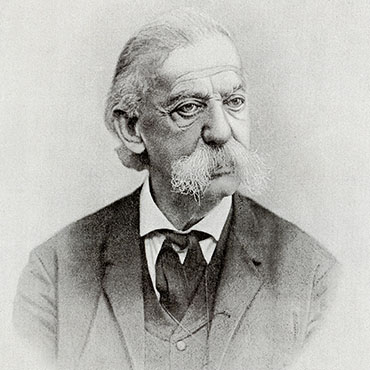Turazza was born in 1813 at Malcesine, on the Verona side of Lake Garda and was the descendant of a family of lawyers. His father, who was also a law graduate in Bologna, in line with the family tradition, but he had totally different ambitions: he set up a company of comedians and abandoned his wife and his son, after cleaning out the house and the money. The mother, therefore, was forced to deal by herself with the education and maintenance of the child, who attended the elementary schools in the village and later the secondary school of San Sebastiano and the high school in Verona, where in both the humanities and sciences he was taught by capable teachers, including Giacinto Toblini for mathematics and Abbot Giuseppe Zamboni for physics. Outside of school, he went to the meetings of the linguist Antonio Cesari, “the father of Tuscan eloquence” and always felt in debt to Cesari for what he had learnt about writing in Italian.
His family ties with Toblini, a mathematician and engineer, with whom Turazza used to spend every summer at Malcesine, provided continuous guidance, even in the holidays. Despite his difficult economic conditions, in 1831 he enrolled at the University of Padua, where the modest calibre of many of the teaching staff, considered by Favaro not to be up to the skills of the young Turazza, enabled him to enjoy the close contacts of a profitable pupillage only with Giovanni Santini and Carlo Conti, teachers of astronomy and sublime calculus. After a period when he worked as assistant in the department of agriculture, he obtained a second degree in philosophy and spent a period teaching in high schools. In 1841 Turazza was awarded the chair of descriptive geometry at the University of Pavia. In the preceding years his work at the Observatory and the Botanical Garden led to a chance encounter with the notary Antonio Piazza, an important person in Padua, a cultured man and a passionate collector. This represented a turning-point in his life, because he fell in love with Piazza’s niece Laura and married her in 1839, despite the reluctance of her family to accept their difference in social class.
In 1842 he was made professor of geodesy and hydrometry at the University of Padua and soon became a full member of the Istituto veneto di scienze, lettere ed arti. In those years mathematical studies at the University of Padua were undergoing a radical change through the creation of their own faculty, which, alongside the older teachers, Santini and Conti, included new recruits from Turazza’s generation, such as Serafino Raffaele Minich, Gustavo Bucchia and Giusto Bellavitis. In 1848, as head of the city’s civil guard, Turazza took part in the anti-Austrian insurrection. After the imperial restoration he remained in Padua, although he was monitored and also punished, in that he was denied the deanship of the faculty. In the 1850s he set up a course of applied mathematics (of which he later became professor), alongside his teaching of hydraulics. Turazza was dedicated also to the study of the humanities and literature, and as vice-president of the Istituto veneto he contributed extensively to the celebrations for the sixth centenary of Dante, the symbol of Italian identity, and once he was nominated president, he readmitted those members that had been dismissed for political reasons.
He resigned all his posts when the House of Savoia replaced the Austrian Empire after the unification of Italy, but he was soon reappointed and even became part of the ministerial committee for university teaching and postgraduate institutes. When he was elected to the provincial council of Padua, he made use of his knowledge by dealing with the water problems and the infrastructures for trains and trams. But rather than politics and administration, his career revolved around the University, of which he was Chancellor, principal of faculty and also director of the training school for engineers, which he insisted on establishing and at which Antonio Favaro was a student. In the training school he provided the teaching of rational mechanics and practical hydraulics. As a scholar of pure and applied mathematics, who was not particularly concerned about the publication of his work, he left contributions in the fields of industrial mechanics and, above all, hydraulics, a subject in which he was acknowledged as having particular competencies and for which he was often asked for his opinion and advice. He was also a member of numerous academies and was awarded many honours, including nomination as a senator, once he had spent seven years as a member of the Regia Accademia delle Scienze.
Domenico Turazza did not survive an influenza that struck him in 1892. His body had been weakened by a heart problem that affected him after the loss of his wife. In his commemoration at the University of Padua, Antonio Favaro maintained that he had “truly died of love”. He had found Turazza to be a “teacher of the friendliest kind”, and discovered him to be “united by the sweetest ties” after Favaro had married Turazza’s daughter Giuseppina. First as a student, then as a colleague and later still as a son-in-law, Favaro described him as an imposing man, both in physical and moral height, austere, cultured, but at the same time gentle and friendly. “From the school,” he concluded, “he had banished that sad severity that breeds a lack of love, making use of that festive gravitas that still inspires a loving respect. In him, more than knowledge, of which he had so much, one could praise a rare and fundamental gift of teachers, which is the art of inspiring love of himself and of study.”


